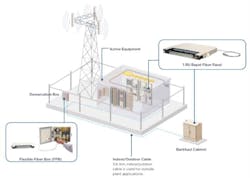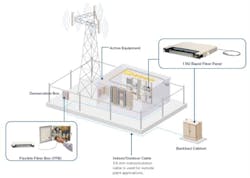Fiber innovations keep up with mobile application demands
Optical fiber is the backbone of the world’s global information infrastructure and a key conduit to enable the ever-increasing demand for high-speed, media-rich mobile communications. Mobile operators need to maximize their limited infrastructure with fiber to keep up with data demand. New technologies help by balancing the upfront cost and ongoing network maintenance costs of fiber while enabling faster deployment of fiber-optic networks. In this article, we’ll look at some of the new technologies that are making fiber easier and more cost-effective to deploy in mobile networks.
New demand, new fiber technologies
With more than 5 billion cell phones in the world, mobile operators are scrambling to provide the voice and data services subscribers demand. According to a Cisco study, mobile data traffic is expected to increase 39X between 2009 and 2014, and 66 percent of the data traffic will be video. To handle the rise in data traffic, mobile operators must upgrade legacy T1 backhaul connections from cellular base stations to fiber, and they must significantly increase network density by installing more fiber-fed base stations in more places.
There are several new technologies that address the cost and time to deploy new fiber in mobile networks.
The first is optical multiplexing – CWDM and DWDM – which is the ability to carry several wavelengths on a single fiber. While wavelength multiplexing isn’t new, the use of CWDM and DWDM in wireless telecommunications networks is new. CWDM enables operators to avoid trenching new cable by making it possible to fit eight wavelengths on an existing fiber; some CWDM systems even scale to 16 and 32 wavelengths per fiber.
New, compact CWDM mux/demux adapters make it easier and less intrusive to use CWDM in a variety of situations, including metro and access network applications. CWDM is attractive because it offers a less expensive price point than DWDM. DWDM can carry 40 wavelengths (some DWDM systems even offer 160-wavelength transport), but the optics and lasers are more expensive than those of CWDM, making DWDM primarily a long-haul technology today.
New intelligent technologies also are being added to the network physical layer to address operational expense management and keep pace with the rate of network change. These technologies are sometimes referred to as “managed connectivity” and slash the cost of maintaining a fiber network. Managed connectivity brings the same visibility and management to the physical layer of the network as do other systems for Layers 2-7. Traditionally, physical networks have been tracked and managed through spreadsheets and network diagrams, and some estimates are that network technicians spend up to 70 percent of their time updating tracking mechanisms. Managed connectivity automates the process of tracking the state of the physical network.
Managed connectivity is implemented by using microchips, RFID tags, or QR codes on connectors and network elements to feed information about the physical connections to an element management system. With managed connectivity, technicians can know exactly the physical state of the network before they travel to a site for maintenance work. Rather than using spreadsheets or network diagrams that may not be up-to-date, the mobile operator has a complete, real-time picture of what is connected to what. Rather than spending the better part of an hour figuring out where the problem is, technicians can use a managed connectivity map to go directly to the problem and fix it quickly.
Fiber-optic connectors also have evolved to support faster and easier fiber deployment by eliminating field splicing. Hardened MultiFiber Optic Connectors (HMFOCs) and similar offerings for indoors have reliable push-on connectors with fewer parts involved in making a given connection. Many fiber jobs are held up while the splicing expert makes connections; push-on connectors eliminate high-cost splicing gurus and let ordinary installers get right to work connecting fiber.
Another innovation is rapidly deployable pull-out fiber distribution panels with preconnectorized cables already attached (Figure 1). These panels enable installers to pull out as much fiber as needed without having to pre-measure and order fiber patch cords of specific lengths. The panels fit inside the fiber distribution frame and use six, 12-strand microcables to make 12 connections per fiber, or 72 connections per panel. Excess fiber is stored inside the panel, and each connection is made with the optimal length of fiber.
These field distribution panels also help the operator with inventory, SKU management, standardization, and using a lower-cost workforce. When combined, the connectorization and rapidly deployable fiber panel technologies reduce total cost by as much as 60 percent.
An example deployment
To see how these technologies can work together, let’s look at a wireless services deployment in a large venue such as a sports stadium. The stadium was to be covered with a distributed antenna system (DAS), which takes the cellular signal from an on-site base station and transmits it throughout the stadium via distributed antennas.
As deployed, the specification for the stadium’s DAS called for a 196-strand fiber bundle between the base station and the point of entry (POE) into the stadium, and a 144-strand fiber bundle to intermediate fiber distribution frames (IDFs) inside the stadium. The system itself didn’t require this much fiber, but the developer wanted to ensure that there was enough extra fiber deployed to meet any future need. The installation required termination and splicing of more than 1200 fiber strands.
The fiber innovations we’ve described would have made the deployment much faster and less expensive. First off, the installation team could have used fiber more efficiently via CWDM. With a 1-to-8 mux/demux, the team could have eliminated 78 percent of the fiber strands by using CWDM at the DAS head-end and pushing the fiber as deep as possible into the optical distribution network.
Figure 2 shows the capacity difference that can be achieved when using these technologies. In addition, the approach described on the right side of the figure uses 12-fiber micro-cable with push-on (MPO) connectors to eliminate the need for field splicing of fiber.
Fiber distribution panels were also deployed at IDFs in the stadium to connect secondary DAS expansion units with the main head-end. Because the rapid distribution panels with push-on connectors were used, this eliminated the need to splice or terminate fibers in the field.
Yet the use of push-on connectors throughout the deployment would have eliminated some 1200 splices, saving time and labor costs. Meanwhile, a managed connectivity approach would have made it easy to pinpoint problems in the physical network if and when they arose.
In this example, advanced fiber technology would have saved 50 percent of deployment costs and would have resulted in a 78 percent savings in the amount of fiber deployed. The deployment would also have been achieved much more quickly, since 1200 splices would have been eliminated. And managing the system would have been simplified through managed connectivity, which would eliminate the need to maintain spreadsheets and network diagrams manually.
Mobile operators will be laying a lot of fiber in the coming years. Fiber connectivity vendors are continually working on innovations to make the process faster and less costly. CWDM, push-on connectors, reel-based fiber panels, and managed connectivity are all techniques that are speeding the deployment and reducing the costs of mobile networks.
Trevor Smith is the executive director, business development for TE Connectivity’s Telecom Networks business unit. He holds more than 20 patents relating to fiber optics and fiber-optic networks.


